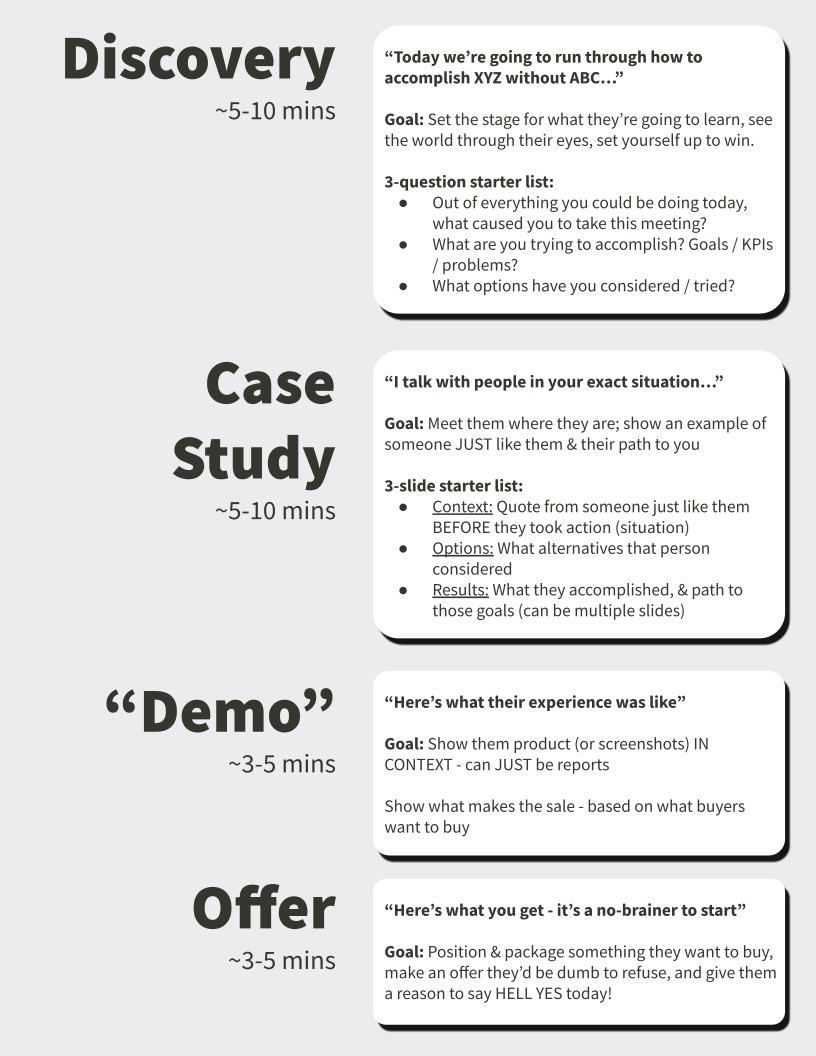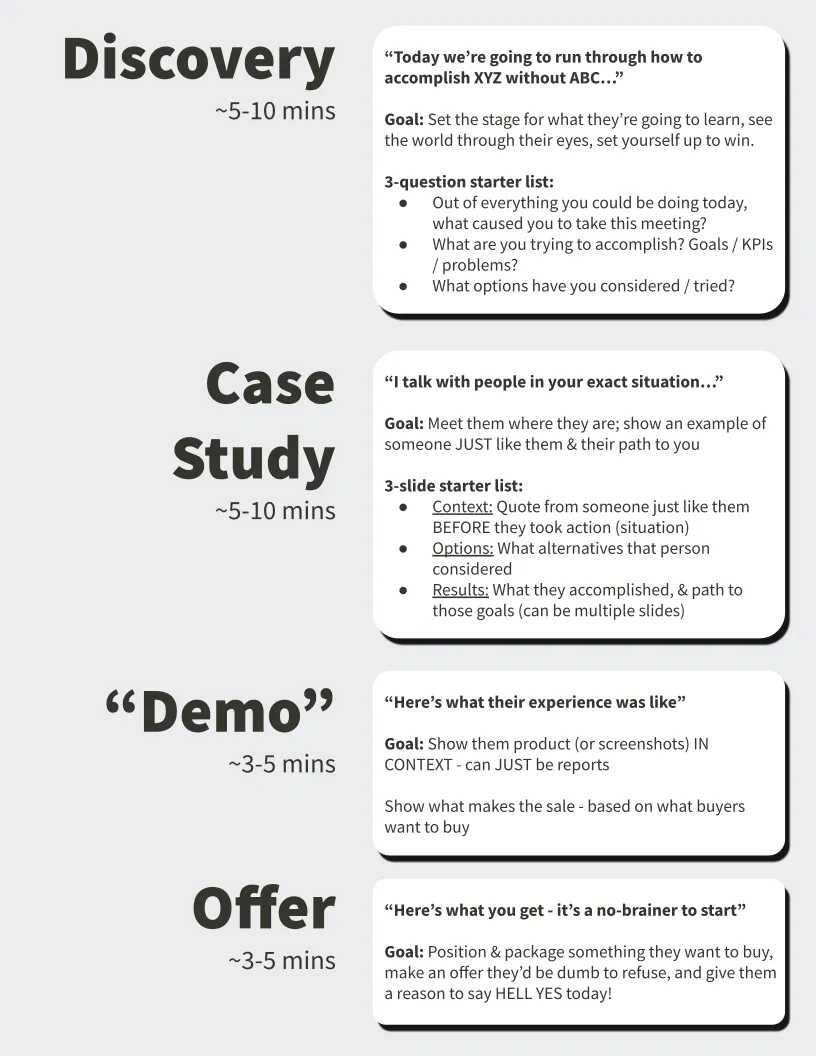“Show me your recorded sales demos, and I’ll tell you everything that’s wrong about your business.”
– Confucius
I keep getting questions about sales demos, so this week I’m going to open the vault and share a bit more.
Components of an effective demo
A demo is where *everything* about your business comes together:
- Your product
- Your messaging
- Your positioning
- Your packaging
- Your “offer”
- Your competitive strategy
- etc. etc. etc.
Last week, I wrote about why your demos underperform when you ONLY focus on them as a “product” or a “sales” thing.
This week, I share a structure for a demo that has worked at a variety of different companies, and will probably work for you. (Debugging required for your specific situation.)
Here are the components of a successful demo:

Here’s how to think about your demo:
The goal is to design a “HELL YES” Offer your customers want to buy. It is a “HELL YES” when it:
- Helps them accomplish something they need to accomplish (this is why just “selling your product” is the wrong approach)
- Is easy to say “yes” to (you’re selling what they want to buy – see Services-Led Growth)
- Gives them a reason to say “yes” ASAP (give them some extra value for buying now vs. waiting, that they can use to make the case to their team)
The point of the sales call / demo is to get them to have the context and confidence they need to get to “HELL YES.” Here’s what it takes:
- You have something big you’re trying to accomplish
- Here’s how someone exactly like you thought about it & approached it
- Here’s what they achieved, and how you can achieve it too
It’s that straightforward.
The problem? Everyone does their demos inside-out. They sell their product, rather than selling a path to accomplishing something a customer *desperately wants* to accomplish.
I’ll break down each piece of a solid sales demo:
Intro + Discovery
Instead of saying, “today you’re going to get a demo of our category-defining product,” you want to frame the demo as: “Today we’re going to learn how people in your exact position are approaching {important thing}, and how we help.”
Remember: It’s about them, not you.
Then, most advice about sales demos tells you to interrogate the potential buyer with discovery questions. Buyers love that, right? Wrong, of course. I don’t want to get waterboarded before I learn about your product.
So I typically recommend 2 – 3 really simple questions that help you see the world from your buyer’s side, and make sure you’re speaking their language when you run through the rest of the demo.
These questions are:
- What brings you here?
- What are you trying to accomplish?
- What options are you considering for accomplishing that thing?
When you understand these three questions, you’re able to stand in your buyer’s shoes. You can see the world as they see it today. Which means you can speak their language.
All other discovery questions can usually get peppered in throughout your sales conversation.
The Case Study
Instead of jumping straight into the product, what’s often most effective is framing any product demo with a story of someone who’s just like this person.
You say, “I talk with people in your exact position all the time. Here’s how they’re typically thinking about things…”
The whole point? Your buyer doesn’t have to think about how THEY would implement this, or whether it fits in their specific situation.
Instead, they see exactly how someone just like them approached the situation. They don’t want to think very hard, customize things very much, or worry that they’re making the wrong decision.
The case study should meet them EXACTLY where they are, and work from where they are to where they want to be.
I tend to break this up into 3 parts:
- “What I typically hear” → This is where I usually include a brief quote from someone just like them. It is the “before” quote: Here’s what I want to accomplish, and here’s what’s holding me back.
- Discovery question: Does this sound familiar? What’s missing?
- “Options this person considered” → This is where I create a list of 3-4 GOOD options for accomplishing their stated goal. And I usually have a talk track that explains why they chose to work with us, versus their other good options.
- Discovery question: Is this how you’re thinking about your options? What’s missing?
- “Results & Path to those results” → This is where I show the “after”: Here’s what this person achieved, which is exactly what they wanted to achieve, and more! This may be a couple of slides – and often this is where you show the product, if you need to.
- Discovery question: Would this accomplish your goals? What’s missing? What questions do you have?
Demo
Sometimes, you’re going to want to show off your product in more detail. You might pick one or two very exciting pieces of your product. For example:
- Pipeline has a very cool AI summarization feature for training documents for EMS providers. Showing this gets a “hell yes” response.
- Bitreel has wildly cool 3D & augmented reality shopping experience for furniture and home goods retailers. Showing this gets a “holy sh*t” response.
In these cases, showing off the product makes a ton of sense. In other cases, you can show more visceral examples of results.
For example, for an employee feedback software, you might show examples of survey responses that the buyer would get. This is more important than giving a run-through of the exact functionality and how they’d use it.
Sometimes, you’re going to want to give a quick walk-through of the product to show how easy + intuitive it is to use. This depends on the kinds of questions you get and the product, though. In most cases, that beautiful product you’ve spent so much time working on is counterproductive to a fast sale. Software products are overwhelming, and buyers are not buying a product, they’re buying outcomes.
Offer
Everything works up to your offer. Startups VASTLY underthink their offers, and instead just have standard pricing tiers that are wildly unexciting.
Instead of worrying about your product, think about what your buyer would say “Hell Yes!” to buying.
In MuukTest’s example, they don’t sell QA Automation software. They sell a “Get Your QA Automated” package, which includes a 1-month proof of concept that has a money-back guarantee. (Nobody’s ever asked for their money back.)
This offer is easy to buy. But more than that: It’s a “HELL YES” for their target customer. At the end of their demos, buyers say, “Where do I sign?”
That’s the point: Design your offer so that it’s a no-brainer.
A few tips and tricks:
- When talking about pricing, it’s important to frame pricing. You can do 1 of 2 ways:
- Here’s what it would cost to do it yourself, and here’s our pricing.
- Here’s each piece of value you get, and here’s our pricing.
- When driving urgency in your offer, it’s better to add value than to offer discounts.
—
So ends the demo playbook. Reach out if you have any questions, or want me to review yours.
